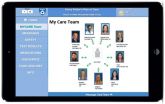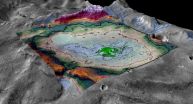(Press-News.org) Scientists searched the chromosomes of more than 4,000 Huntington's disease patients and found that DNA repair genes may determine when the neurological symptoms begin. Partially funded by the National Institutes of Health, the results may provide a guide for discovering new treatments for Huntington's disease and a roadmap for studying other neurological disorders.
"Our hope is to find ways that we can slow or delay the onset of Huntington's devastating symptoms," said James Gusella, Ph.D., director of the Center for Human Genetic Research at Massachusetts General Hospital (MGH), Boston, and the corresponding author of the study published online in Cell. "This could be possible because we now have a list of clinically proven genetic factors that influence the disease."
Huntington's disease is an inherited neurodegenerative disorder caused by mutations in a gene that encodes a protein called Huntingtin. Symptoms usually begin in midlife and include uncontrolled movements, emotional disturbances and, eventually, dementia. Although studies in humans and animals have discovered clues as to how the disorder works, there are no effective treatments.
For this study, the scientists tried a slightly different approach. They employed a novel application of Genome Wide Association Study analysis, a technique that scientists typically use to search for single letter changes to the DNA code on patients' chromosomes, which may increase or decrease their chances of having the disease. Here, the scientists already knew the disease-causing gene and so they used the technique to search for other changes that determine when the disease starts. They found that at least three sites were associated with symptoms appearing earlier or later than expected, two on chromosome 15 and one on chromosome eight.
"This approach could have a significant impact on Huntington's disease patients and researchers," said Margaret Sutherland, Ph.D., program director, the National Institute of Neurological Disorders and Stroke, part of NIH. "It's an example of how precision medicine may be applied to neurological disorders."
The study was conducted by the Genetic Modifiers of Huntington's Disease Consortium, an international team of scientists devoted to finding treatments for the disorder. Starting more than three decades ago they collected DNA samples and clinical information from patients, mainly in the United States, Canada and Europe.
"We thank the patients and their families for their commitment to research," said Dr. Gusella. "It takes a dedicated global effort to meet the complex challenges presented by neurological disorders like Huntington's disease."
The scientists used the patients' DNA and clinical information to study the age when movement problems began. Located on chromosome four, the Huntingtin gene is characterized by three letter repeats in the DNA code, called CAG-repeats. Disease-causing versions of the Huntingtin gene contain more than 35 CAG-repeats, which is higher than the six to 34 repeats found in normal versions. The greater number of CAGs a patient has, the greater the chances that symptoms will appear earlier in life. Focusing on patients who had 40 to 55 CAGs, the scientists found that some developed the disease earlier than expected while others developed it later.
The scientists then analyzed the patients' chromosomes using gene chips that contain sites known for having single letter changes to the DNA code in normal human populations. After multiple rounds of searching they found that two sites on chromosome 15 were strongly associated with disease onset. One site was associated with hastening the disease by, on average, just over six years; another site was associated with slowing the disease by about a year and a half. They also found that a site on chromosome eight was associated with earlier disease onset by nearly one and a half years.
Although the scientists did not identify specific genes, they used several types of genome network analyses to show that disease onset may be controlled by genes that repair DNA, catalyze essential chemical reactions in cells, and assist with the division of mitochondria. In addition, they noted that a site within the code for MLH1, a DNA repair gene located on chromosome three, may be involved. Finally, the scientists showed that the sites on chromosomes 15 and eight may be associated with the beginning of psychiatric and cognitive problems caused by the disease.
"These results are an important step toward developing new treatments for Huntington's disease. They help us understand how, through evolution, nature has learned to modify the disease-causing effects of Huntington's disease mutations," said Dr. Gusella. "As we study more patients we hope the information we obtain will soon reduce their suffering."
INFORMATION:
This work was supported by grants from NIH (NS082079, NS091161, NS016367, HG002449, HG006074), the Medical Research Council (UK; G0801418, MR/L010305/1) and the CHDI Foundation.
References:
Genetic Modifiers of Huntington's Disease (GeM-HD) Consortium. "Identification of Genetic Factors that Modify Clinical Onset of Huntington's Disease," Cell, July 30, 2015. DOI: 10.1016/j.cell.2015.07.003
For more information, visit:
http://www.ninds.nih.gov/disorders/huntington/huntington.htm
http://www.ninds.nih.gov
http://www.genome.gov
NINDS is the nation's leading funder of research on the brain and nervous system. The mission of NINDS is to seek fundamental knowledge about the brain and nervous system and to use that knowledge to reduce the burden of neurological disease.
NHGRI is one of the 27 institutes and centers at the National Institutes of Health. The NHGRI Extramural Research Program supports grants for research and training and career development at sites nationwide. Additional information about NHGRI can be found at http://www.genome.gov.
About the National Institutes of Health (NIH): NIH, the nation's medical research agency, includes 27 Institutes and Centers and is a component of the U.S. Department of Health and Human Services. NIH is the primary federal agency conducting and supporting basic, clinical, and translational medical research, and is investigating the causes, treatments, and cures for both common and rare diseases. For more information about NIH and its programs, visit http://www.nih.gov.
Scientists on the NOvA experiment saw their first evidence of oscillating neutrinos, confirming that the extraordinary detector built for the project not only functions as planned but is also making great progress toward its goal of a major leap in our understanding of these ghostly particles.
NOvA is on a quest to learn more about the abundant yet mysterious particles called neutrinos, which flit through ordinary matter as though it weren't there. The first NOvA results, released this week at the American Physical Society's Division of Particles and Fields conference ...
WORCESTER, MA -- Researchers at the University of Massachusetts Medical School have found that Google Glass, a head-mounted streaming audio/video device, may be used to effectively extend bed-side toxicology consults to distant health care facilities such as community and rural hospitals to diagnose and manage poisoned patients. Published in the Journal of Medical Toxicology, the study also showed preliminary data that suggests the hands-free device helps physicians in diagnosing specific poisonings and can enhance patient care.
"In the present era of value-based care, ...
Health care organizations have been implementing health information technology at increasing rates in an effort to engage patients and caregivers improve patient satisfaction, and favorably impact outcomes. A new study led by researchers at Brigham and Women's Hospital (BWH) finds that a novel web-based, patient-centered toolkit (PCTK) used by patients and/or their healthcare proxys in the hospital setting helped them to engage in understanding and developing their plan of care, and has the potential to improve communication with providers. The results of the study are ...
Australian scientists have discovered many tropical, mountaintop plants won't survive global warming, even under the best-case climate scenario.
James Cook University and Australian Tropical Herbarium researchers say their climate change modelling of mountaintop plants in the tropics has produced an "alarming" finding.
They found many of the species they studied will likely not be able to survive in their current locations past 2080 as their high-altitude climate changes.
The Wet Tropics World Heritage Area in Queensland, Australia is predicted to almost completely ...
A James Cook University study shows fish retreating to deeper water to escape the heat, a finding that throws light on what to expect if predictions of ocean warming come to pass.
JCU scientists tagged 60 redthroat emperor fish at Heron Island in the southern Great Barrier Reef. The fish were equipped with transmitters that identified them individually and signaled their depth to an array of receivers around the island.
The experiment monitored fish for up to a year and found the fish were less likely to be found on the reef slope on warmer days. Scientists think ...
Mars turned cold and dry long ago, but researchers at the University of Colorado Boulder have discovered evidence of an ancient lake that likely represents some of the last potentially habitable surface water ever to exist on the Red Planet.
The study, published Thursday in the journal Geology, examined an 18-square-mile chloride salt deposit (roughly the size of the city of Boulder) in the planet's Meridiani region near the Mars Opportunity rover's landing site. As seen on Earth in locations such as Utah's Bonneville Salt Flats, large-scale salt deposits are considered ...
Ruxolitinib (trade name: Jakavi) has been approved since March 2015 for the treatment of adults with polycythaemia vera, a rare disease of the bone marrow. It can be used when the drug hydroxyurea is ineffective or not tolerated. The German Institute for Quality and Efficiency in Health Care (IQWiG) examined in a dossier assessment whether this drug offers an added benefit over the appropriate comparator therapy.
According to the findings, ruxolitinib offers better relief of individual symptoms and improves quality of life. Dyspnoea and muscle cramps are more frequent, ...
Brussels, [7 August 2015] - An unresolved inflammatory response is likely to be involved from the early stages of disease development. Controlling inflammation is crucial to human health and a key future preventative and therapeutic target. In a recent ILSI Europe's article published in the British Journal of Nutrition, a coalition of experts explain how nutrition influences inflammatory processes and help reduce chronic diseases risk.
Inflammation is a normal component of host defence, but elevated unresolved chronic inflammation is a core perturbation in a range of ...
Simon Fraser University scientist Jonathan Moore has authored new research suggesting that a proposed controversial terminal to load fossil fuels in the Skeena River estuary has more far-reaching risks than previously recognized.
In a letter newly published in the journal Science Moore and First Nations leaders and fisheries biologists from throughout the Skeena watershed refer to the new data, which is on the Moore Lab site.
Moore is a Faculty of Science and a Faculty of Environment professor of ecology and conservation of freshwaters and the Liber Ero Chair of Coastal ...
HOUSTON, August 6, 2015 - This week marks the 50th anniversary of the Voting Rights Act. This week also marks a watershed ruling by a federal appeals court striking down the controversial Texas voter ID law as violating that landmark civil rights act.
A new study conducted by the University of Houston Hobby Center for Public Policy and Rice University's Baker Institute for Public Policy examines the impact of the contested Texas law in U.S. Congressional District 23 (CD-23).
The study suggests that the most significant impact of the Texas voter photo ID law on voter ...



